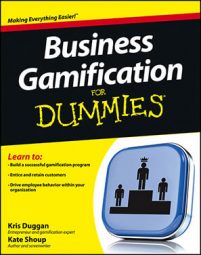Gamification refers to the use of game mechanics and rewards in a non-game setting to increase user engagement and drive desired user behaviors. Gamification in business is used to increase such things as stickiness, sharing, content creation, and purchases.
So what are some of the industries that are already using gamification? Here are just a few:
Retail and e-commerce
Politics
Healthcare
Nonprofit
Human resources
World-class retailers, e-commerce communities, and consumer brands — including Footlocker, Samsung, Bluefly, Barnes & Noble, General Mills, and Dannon — rely on gamification to meet key business objectives.
Gamification in politics
In an attempt to engage constituents of varying age groups, some political campaigns have begun to tap into gamification. For example, during the 2012 presidential campaign, Barack Obama’s campaign website ran a contest— the prize: dinner with the president and First Lady — to persuade site visitors to donate.
Perhaps an even more overt example was the Obama campaign’s G.O.P. Debate Watch site, where Democratic supporters could play a game in which they pledged to donate each time a Republican candidate used a word from a pre-designated “hot list” during the debate (think Obamacare, flat tax, socialism, and so on). Gamification is also used by political campaigns to foster competition among canvassers — in a fun way.
Gamification in healthcare
Healthcare is one area where gamification has really taken off. Indeed, loads of health insurers, including UnitedHealth Group, BlueCross BlueShield, and Aetna, have launched initiatives to gamify their offerings. For example, Aetna’s online social game, Mindbloom, helps members improve health and wellness and lead a more balanced life.
In addition, several startups have emerged, using gamification in an attempt to make fitness more fun. Here are just a few:
Nike+ enables members to track activities, compare results, set goals, and improve performance — as well as receive training tips and tricks from world-class coaches. Games, challenges, and virtual competitions with friends help users stay inspired.
With Fitocracy’s free iPhone app, users can log their workouts and receive points for them. As they do, they earn achievements and badges, as well as take on new challenges. Engagement is further promoted through the use of social tools. For example, users can add friends, join groups, follow others, chat, comment, and compare results.
GymPact helps members stick to their workouts by rewarding them with cash when they do — paid for by members who fail to work out as promised.
With HealthRally, members can reward friends or family members for meeting fitness goals, or ask friends and family members to reward them.
A service called EveryMove, currently in beta, will enable members to earn rewards, such as discounts on health insurance by achieving health goals.
Gamification in nonprofit
The nonprofit world has used gamification to great effect to build awareness of critical causes and increase engagement. Movember, an organization that promotes awareness of prostate cancer and other male-related cancers, is perhaps best known for its annual mustache-based fundraising challenge in November of each year. Movember motivates its ‘stache-growers by issuing clever challenges and offering big rewards, including the highly coveted International Man of Movember.
Gamification in HR
Human resources officials in several organizations have begun to use gamification to recruit and motivate employees. For example, in an effort to motivate senior executives to complete its leadership development program, Deloitte has gamified its Deloitte Leadership Academy, a program that delivers lessons from world-renowned business schools (such as Harvard and Stanford). As participants complete programs, contribute, and share knowledge, they earn badges and other rewards — which are portable to sites like LinkedIn and Twitter.
A more extreme example might be Marriott, which went so far as to develop a FarmVille-style, Facebook-based game called My Marriott Hotel in which players juggle the duties of a hotel kitchen manager. The idea is to acquaint young workers with the industry in the hopes of recruiting them. This goes beyond mere gamification to the creation of an actual game.

